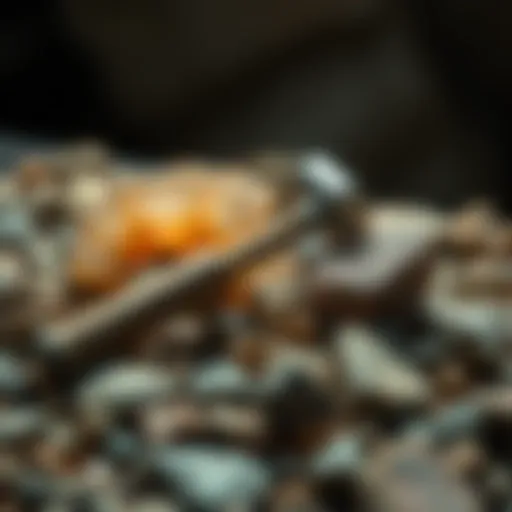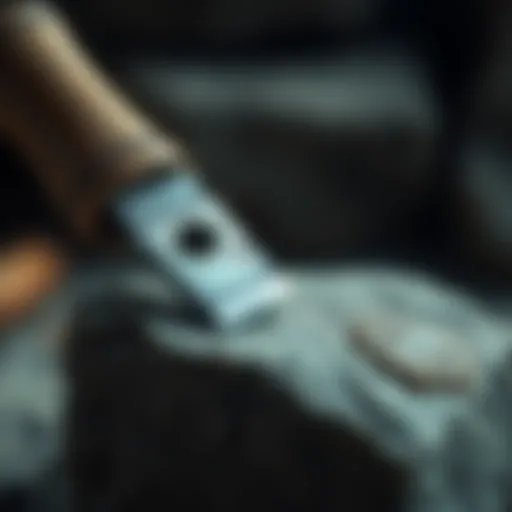Exploring the Allure of Amethyst Skulls: Art and Spirit


Overview of the Topic
Amethyst skulls have attracted interest in diverse areas, from art to spirituality. They are carved from the mineral amethyst, which belongs to the quartz family. The skull shape evokes various interpretations and symbols across cultures.
Definition of Key Terms
- Amethyst: A purple variety of quartz valued for its understated beauty and spiritual associations.
- Skull Carving: The art of sculpting material into a resemblance of a skull. This practice can hold different meanings depending on the cultural context.
- Collectibles: Items sought after by collectors due to their rarity or aesthetic appeal.
Historical Significance
The use of amethyst dates back to ancient civilizations. The ancient Greeks and Romans valued it for both its beauty and supposed protective properties. Over centuries, the meaning of amethyst transitioned towards spiritual growth and healing. Skulls started appearing in various aspects of art reflecting deeper meanings connected to life and death.
Types of Collectibles
Amethyst skulls can be categorized under multiple classifications, appealing to various types of collectors.
Classification of Different Collectibles
- Natural vs. Carved: Natural amethyst pieces are unaltered, while carved ones showcase artistic craftsmanship.
- Size Variation: Smaller skulls are often popular for personal collections, while larger pieces tend to be focused on display.
Notable Categories
- Artistic Skull Pieces: These are unique carvings showcasing the skill of the artist.
- Healing Crystals: Some collectors value amethyst skulls for their supposed energetic properties.
- Skeletal Art: These often blend traditional skull designs with modern aesthetic themes, attracting art collectors.
"The amethyst skull stands as a symbol blending geological wonder and artistic endeavor, bridging material beauty with metaphysical inquiry."
In closing, amethyst skulls encompass various themes integrating historical significance, artistic expression, and collector interest. Understanding these facets can enhance appreciation for this unique collectible.
Prelude to Amethyst Skulls
Amethyst skulls are becoming a remarkable topic in the realms of art and spirituality. Their appeal is multifaceted, bridging the interests of collectors, artisans, and those drawn to metaphysical beliefs. This section aims to outline the significance of amethyst skulls, clarifying their role in various cultural contexts and their allure in the contemporary marketplace.
Importance and Relevance
The prevalence of amethyst skulls can be attributed to both their aesthetic value and the deep spiritual connections many individuals seek. Collectors appreciate them for their unique craftsmanship. Each skull reflects the skill of the artist, often showcasing intricate details that make these items pieces of art. Moreover, amethyst itself is known for its rich purple hue, which can vary significantly in saturation and clarity. This natural variation adds to the character and desirability of each piece.
Benefits and Considerations
For collectors, amethyst skulls are more than mere adornments. They serve as conversation starters and can be linked to a range of beliefs surrounding healing and energy. Many enthusiasts regard amethyst as a stone of protection and purification. Thus, owning these skulls can evoke a sense of connection to ancient traditions and metaphysical properties.
However, potential buyers and collectors should consider authenticity and sourcing. As interest rises, so does the risk of encountering replicas or poorly sourced items. It is essential to ensure that purchases come from reputable dealers who can provide information on the provenance of their pieces. This aspect of collecting can enrich the experience, offering a deeper appreciation for each item.
Finally, the intention behind owning an amethyst skull can be highly personal. Whether for decorative purposes, spiritual use, or collection, understanding the reasons people are drawn to amethyst skulls enhances the collective knowledge about these fascinating objects.
"Amethyst skulls represent a unique intersection of art, culture, and spirituality, captivating those who seek beauty, history, and meaning."
The Origin of Amethyst
Understanding the origin of amethyst is foundational for appreciating its significance in diverse domains such as art, spirituality, and collecting. This vibrant purple gemstone is not only visually appealing but also carries with it a rich history that enhances the allure of products made from it, especially skull carvings. The process of how amethyst forms and where it can be found adds depth to its value and desirability among collectors.
Geological Formation
Amethyst is a variety of quartz characterized by its striking purple hue. The color results primarily from the presence of iron in the quartz structure. During the geological formation, the silica minerals found in volcanic rocks crystallize under specific temperature and pressure conditions. This is where unique attributes of amethyst emerge. Striking hues from light lavender to deep violet can occur, depending on factors such as iron concentration and natural radiation.
The geological processes involved in forming amethyst can be quite lengthy, spanning millions of years. As lava cools, gas bubbles can create pockets where conditions are perfect for quartz crystals to form. These geodes can be later discovered and mined, showcasing beautiful, fully formed crystals that display exceptional clarity and luminosity. This geological journey gives amethyst its distinctive characteristics and texture, making it uniquely suitable for carving into skull shapes.
Global Sources
The sources of amethyst are quite diverse, with significant deposits located throughout the world. Prominent areas include Brazil, which is known for producing large amethyst geodes, and Uruguay, where high-quality crystals are often found. Other notable mining regions include Zambia, Madagascar, and South Korea. Each location provides amethyst with unique visual features—Brazilian amethyst tends to be light to medium purple, while Zambian amethyst is celebrated for its darker tones.
When sourcing amethyst, it is crucial to consider not only the geographic origin but also the ethical standards of mining practices. Collectors often look for origins associated with responsible extraction methods. This includes respect for the environment and the rights of workers involved in mining operations. In recent years, the market has become increasingly aware of ethical practices, paving a path for the lore surrounding amethyst to extend beyond mere beauty, imbuing it with a deeper narrative of sustainability and respect.
"The journey of amethyst from geological formation to the hands of skilled artisans reflects both nature's artistry and human craft."


By grasping these elements regarding the origin of amethyst, collectors gain a richer understanding of what makes amethyst skulls not just objects but also a connection to the earth's history and the intricate processes that give them life.
Artistry in Skull Carving
The artistry involved in carving amethyst skulls stands as a centerpiece in the appreciation of these unique items. It encapsulates both the technical skill of the artisans and the rich cultural context surrounding the creation of these sculptures. Understanding the artistry behind skull carving is essential for collectors and enthusiasts alike, as it enhances the value and meaning of these treasured pieces. The intricate details achieved in each carving not only showcase the material's beauty but also reflect the heritage of the craftsmen.
Tools and Techniques
Skull carving requires various specialized tools and techniques that are crucial in shaping the amethyst into intricate forms. Artisans usually begin with chisels and saws designed specifically for stone carving. These tools enable the precise removal of material, permitting fine details to emerge. In addition to chisels, rotary tools like Dremels are increasingly popular, as they facilitate more intricate designs and smoother finishes. The methods applied vary among artists; some prefer traditional hand tools for greater control, while others embrace modern technology for efficiency.
The process begins with selecting a high-quality piece of amethyst. After the initial shaping, finer details are achieved through meticulous sanding and polishing. One common technique is cabochon cutting, which rounds off the skull's surface to give it a sleek sheen. This process takes time and demands patience, illustrating the dedication artists have towards their craft.
"The beauty of amethyst skulls lies not only in their stunning appearance but in the painstaking craftsmanship that brings them to life."
Artists and Their Styles
The diversity of artists involved in amethyst skull carving contributes significantly to the allure of these pieces. Each artist brings their individual style, influenced by cultural background and personal vision. Some artisans focus on creating highly realistic representations, while others may adopt an abstract or geometric approach. This variation is beneficial for collectors who appreciate the distinctiveness of each piece.
Moreover, certain artists are renowned for their mastery, attracting collectors who seek out their work. Some names have become synonymous with exceptional quality and creativity, such as the celebrated carver David M. Radtke. His intricate designs often blend traditional motifs with modern elements, making each skull a unique narrative.
Understanding the differences between artists and their styles helps collectors and enthusiasts make informed purchases. It fosters a deeper connection to the art form and encourages appreciation for the craftsmanship involved. Thus, the artistry behind skull carving influences not only the visual appeal but also the storytelling aspect, depending on the artist's background and technique.
Cultural Significance of Amethyst Skulls
The cultural significance of amethyst skulls spans across various dimensions, entwining history with spirituality and collective beliefs. They stand as remarkable symbols in numerous cultures, captivating collectors and enthusiasts alike. This section will explore how they fit into different societies historically, alongside the spiritual beliefs that further enhance their allure.
Historical Context
Amethyst itself has held a prominent place in human history. In ancient times, the stone was considered precious and bestowed with unique powers. The Greeks, for example, believed that amethyst could prevent intoxication, embodying clarity and self-control. They often carved drinking vessels from it. This connection reflected a broader trend of associating this stone with protection and balance.
In many cultures, skull carvings represent mortality. The use of amethyst in such designs hints at a dual acknowledgment of life's fragility while also embracing the protective qualities attributed to the stone. Historical records indicate that various civilizations, from the Egyptians to the Aztecs, valued skulls as ceremonial objects symbolizing the passage to the afterlife.
Furthermore, the Renaissance period saw a renewed interest in gemstones, including amethyst. Artists created intricate pieces that featured not just amethyst but also skull motifs, illustrating the intertwined narrative between aesthetic beauty and ethereal beliefs. This historical context emphasizes the skulls not merely as decorative art, but also as reminders of deeper ideas regarding existence and spirituality.
Spiritual Associations
Amethyst skulls have gained recognition in the realm of spirituality, weaving together beliefs in intuition, healing, and energy alignment. The crystal's properties are often linked to clarity of mind and heightened perception. Many spiritually inclined individuals use these skulls in meditation practices, believing they can amplify spiritual energies, promote tranquility, and facilitate connection to higher realms.
Their deep purple hue is frequently associated with the crown chakra, often regarded as a gateway to transcendent experiences. This connection elevates amethyst not only as a precious stone but as a tool for introspective and spiritual growth. Enthusiasts often cite increased intuition and psychic abilities when working with these skulls, which leads to a community of individuals who value personal transformation.
Moreover, amethyst skulls frequently feature in alternative healing practices. Practitioners assert that these sculptures can assist in emotional healing, bringing comfort to those in distress. Many believe they possess the capability to dispel negative energy and foster a balanced emotional state.
"The allure of amethyst skulls lies deeply in their rich historical lineage and the spiritual resonance they carry, merging art with profound meaning."
Metaphysical Properties of Amethyst
The metaphysical properties of amethyst hold significant importance in the sphere of holistic health, spirituality, and self-exploration. Much like other crystals, amethyst is attributed with various healing and transformative qualities. It is essential for both enthusiasts and collectors to understand these dimensions, as they enhance the value and appreciation of amethyst skulls beyond mere aesthetics.
Amethyst is often seen as a powerful protective stone. It is believed to guard against negative energies, promoting a sense of calm and stability. This stone also encourages emotional balance and introspection. The tranquil nature of amethyst promotes clarity of thought and a deeper understanding of one’s emotions.
A deeper dive into the metaphysical properties reveals specific elements that merit attention.
- Energy Work: Amethyst is commonly used during energy work, such as chakra balancing. Its vibration resonates with the crown and third eye chakras, fostering spiritual awareness and insight.
- Meditative Practices: Many use amethyst during meditation to enhance their practice. It is said to help one tap into deeper states of consciousness, facilitating spiritual growth.
- Intuition and Guidance: Collectors often seek amethyst for its reputed ability to enhance intuition. It is thought to assist individuals in connecting with their higher selves, aiding in decision-making processes.
When we talk about the relevance of these metaphysical properties to amethyst skulls, it creates a layered narrative. Beyond their artistic and aesthetic appeal, these skulls serve as tools for personal transformation and growth. They appeal not only to collectors but also to spiritual practitioners who value their energetic potency.
Healing and Energy Work
The healing properties associated with amethyst specifically focus on its ability to aid both physical and emotional healing. Practitioners of energy work often utilize amethyst skulls for balancing the body's energies. This process entails placing the skull on or near affected areas of the body during healing sessions. The connection between the quartz crystal and the person can foster a soothing ambiance.
Some have reported relief from stress and anxiety when incorporating amethyst into their practices. People often hold the skull while meditating or during yoga to enhance their mental and emotional state.
Key benefits include:


- Relaxation and Stress Relief: Well-known for its calming effects.
- Enhanced Energy Flow: Encourages the free flow of energy throughout the body.
- Healing Energies: Identified as beneficial for various ailments, from headaches to emotional disturbances.
Thus, amethyst not only serves as a decorative art piece but also meets the needs of those searching for healing through spiritual means.
Dream and Intuition Enhancement
Amethyst skulls also claim to enhance dreams and intuition, making them interesting for those who seek to explore their subconscious and improve their psychic abilities. Many collectors regard them as portals to deeper levels of consciousness during sleep.
The association of amethyst with enhancing dreams is tied to its reputed ability to bring clarity to the dream state. It is thought to aid in remembering dreams, interpreting their meanings, and distinguishing between dreams and intuition. Collectors often place amethyst skulls near their bedside or under their pillow, hoping to cultivate vivid and insightful dreams.
- Intuitive Practices: Users frequently find that holding amethyst while engaging in meditation helps sharpen their psychic perceptions.
- Enhanced Clarity of Thought: Users often report improved clarity in decision-making processes, attributing this gift to the influence of amethyst.
- Dream Clarity: Enhances the ability to discern messages from dreams, aiding in personal growth.
The Market for Amethyst Skulls
The market for amethyst skulls is a multifaceted arena reflecting the intersection of artistry, spirituality, and collector enthusiasm. As the interest in unique collectibles continues to rise, understanding the dynamics of this market becomes increasingly important. Collectors not only seek the aesthetic appeal of skulls but also the intricate stories and beliefs woven into their creation. With amethyst's famed beauty and recognized healing properties, it is no surprise that these items attract a dedicated following. The importance of this market in the overall discussion surrounding amethyst skulls lies in its ability to convey the value and allure that these pieces hold in both art and culture.
Value Determinants
Several factors come into play that impact the perceived value of amethyst skulls. These depend on attributes such as:
- Quality of the Amethyst: The depth of color and clarity affects the allure of the skull. Rich, deep purple hues are particularly desirable.
- Size and Weight: Larger skulls typically command higher prices. The weight of the piece can also contribute to its value, as larger blocks of quality amethyst are harder to come by.
- Artisan Craftsmanship: A skull carved by a renowned artist may fetch a premium. The skill involved in transforming raw amethyst into a polished artwork is significant.
- Unique Features: Elements such as intricate designs or unique inclusions can elevate a skull's value.
- Market Demand: Trends within the collector community can also affect pricing. Skulls that follow current trends may see a spike in interest and therefore, value.
Each of these factors plays a crucial role in determining how amethyst skulls are priced and sold in the market.
Authenticity and Ethical Sourcing
The issues of authenticity and ethical sourcing cannot be overlooked in discussions about the market. In an age where consumers are increasingly conscious about the origins of their collectibles, ensuring that amethyst skulls are ethically sourced is paramount. Authenticity hinges on several aspects:
- Provenance: Knowing where the amethyst has come from adds to its value. Buyers prefer items that can trace their history back to legitimate sources.
- Certificates: Some collectors seek out certificates of authenticity. These documents provide confirmation of the skull's origin and legitimacy.
- Ethical Practices: Collectors are more inclined to support artisans and sellers who demonstrate fairness and sustainability in their sourcing practices. This may involve the use of environmentally friendly methods or equitable treatment of local communities.
"Being informed and educating oneself on the origins of amethyst skulls is essential for any serious collector."
Engaging with suppliers who adhere to ethical standards supports a responsible market while ensuring the longevity and quality of the amethyst skulls. As the market continues to evolve, these considerations will play a critical role in shaping the future of amethyst skull collecting.
Caring for Amethyst Skulls
Caring for amethyst skulls is a crucial aspect of ownership that requires attention and consideration. These unique pieces hold not only sentimental value but also serve as significant items in collections. Proper care is essential for maintaining their beauty and integrity. Neglecting their upkeep can lead to scratches, dullness, or even damage to the crystal structure, which is something collectors want to avoid.
Cleaning and Maintenance
Cleaning amethyst skulls should be done with care. Using harsh chemicals can damage the stone and diminish its natural luster. Here are some recommendations for effective and safe cleaning:
- Soft Cloth: Use a soft microfiber cloth to gently wipe the surface. This method effectively removes dust and minor smudges without scratching the surface.
- Water and Soap: If deeper cleaning is necessary, mix a small amount of mild liquid soap with water. Dampen the cloth in this solution and wipe the skull carefully. Rinse the cloth with clean water and wipe again to remove any soap residue.
- Avoid Direct Sunlight: Keep the skulls out of direct sunlight to prevent fading of the color and potential heat damage.
Regular maintenance is also crucial. Keeping amethyst skulls in a dust-free environment helps reduce the frequency of cleaning. Avoid positioning them near windows where they can be exposed to extreme temperature variations.
Storing Your Collection
Storing amethyst skulls properly is essential to preserve their condition. Here are several important tips for optimal storage:
- Display Cases: Invest in a sturdy glass display case. This not only protects the skulls from dust but also provides a visually appealing way to showcase your collection.
- Cushioning: Use soft padding when placing skulls in storage to prevent movement or contact with hard surfaces.
- Temperature Control: Ensure that the storage area maintains a stable temperature. Fluctuations can lead to cracks. A controlled environment is ideal for the longevity of the crystals.
Maintaining both cleanliness and proper storage practices ensures that amethyst skulls remain captivating and valuable pieces in any collection. By investing time and effort into care, collectors can enjoy their beauty for years to come.
Collectors should remember that the aesthetic value of amethyst skulls is proportional to the level of care they receive.
Collecting Amethyst Skulls
Collecting amethyst skulls represents a growing niche within the world of mineral and gem collecting. This captivating practice not only draws individuals captivated by the beauty of the amethyst itself, but also appeals to those who are fascinated by the ancient and mystical associations tied to skulls. Every piece in a collection embodies a history, craftsmanship, and a conversation starter that adds depth to any gallery or display. The pursuit of amethyst skulls provides collectors with unique rewards, from the aesthetic enjoyment to the potential for future value appreciation.
Finding and acquiring these items involves various considerations. First, one should ensure they are knowledgeable about the different qualities of amethyst, such as color saturation and clarity. Distinguishing between natural and artificially enhanced stones is crucial. Collectors might also consider the provenance of each piece; knowing where the item was sourced can add a significant layer of value and importance. Beyond mere aesthetics, the context in which a skull was carved or crafted can greatly enhance its narrative.
Building a Collection


Creating a collection of amethyst skulls can be a rewarding and enriching endeavor. Start by setting clear goals about what you wish to achieve with your collection. Are you focusing on a specific style, size, or artist? Perhaps you wish to explore various sources and forms of amethyst skulls.
Here are some helpful steps to begin your collection:
- Research Different Designs: Look into various artistic styles. Some artisans create modern interpretations, while others adhere to traditional techniques.
- Network with Other Collectors: Engaging with other enthusiasts can provide insights into collecting strategies and upcoming events or sales.
- Attend Gem Shows: Events dedicated to gemstones and minerals feature vendors that specialize in amethyst skulls, alongside opportunities to meet artists.
- Keep a Collection Record: Documenting details about each piece, including purchase date, price, and any relevant stories, can aid in future valuations and sales.
By being intentional in your collecting approach, you can not only build a unique collection but also enhance your knowledge about rock and mineral collecting.
Community and Resources
The amethyst skull collecting community is rich and diverse. Online forums and social media platforms provide a space for enthusiasts to share their collections, discuss trends, and exchange valuable tips. Websites like Reddit have dedicated threads and groups for collectors interested in sharing their passion for amethyst skulls. Various Facebook groups also cater to this interest, with members frequently showcasing their finds and offering advice.
Moreover, several online resources can help collectors deepen their understanding. Consider exploring:
- Wikipedia: A wealth of background information on amethyst properties and history.
- Britannica: Articles discussing geological and cultural significance.
- Gem and Mineral Shows: Opportunities to meet others in person and learn from experienced collectors directly.
Participating in community activities can profoundly enrich your collecting experience while fostering connections with fellow collectors. This networking not only aids in finding rare pieces but also grants access to shared knowledge.
Collecting amethyst skulls can transform into a deeply personal journey that intertwines beauty, culture, and community.
Engaging with the community and utilizing available resources enhances the overall experience, ensuring collectors are well-informed and inspired.
Controversies in Amethyst Culture
Controversies surrounding amethyst skulls are significant. They reveal societal attitudes toward artifacts, cultural origins, and the ethical issues in collecting. As interest in these unique items grows, so does the need to address misconceptions and cultural appropriation. This section aims to unpack these issues in a clear and concise manner, ensuring that collectors are informed of the complexities that arise in the realm of amethyst skulls.
Misconceptions and Myths
Misconceptions related to amethyst skulls often stem from a lack of understanding. Some believe that all amethyst skulls carry potent mystical energies or that they have healing properties that are universally experienced. However, the effects can vary significantly between individuals. The portrayal of amethyst as a catch-all solution in metaphysical circles can mislead potential buyers and collectors. Furthermore, popular myths suggest that these skulls were crafted by ancient civilizations with unique spiritual insights. In fact, the majority of amethyst skulls available today are modern creations, often made by skilled artisans who bring their own perspectives to the craft.
"The allure of amethyst skulls often masks the essential reality that many are not ancient artifacts but contemporary creations."
Knowing the difference is crucial for collectors wishing to appreciate the true value of their investments. Misunderstandings can lead to inflated expectations and potentially meaningless purchases.
Cultural Appropriation
Another pressing concern involves cultural appropriation. Amethyst skulls may be associated with various spiritual traditions, which raises questions about the original cultural contexts. When these articles are removed from their cultural backgrounds and marketed widely, it may distort their meanings. This practice can unintentionally diminish their original significance, resulting in a commodification of cultural symbols. Collectors should be aware of these dynamics and reflect on the origins of the items they obtain.
Ethical collecting also involves respecting the cultures from which these objects originate. Engaging with artisans and sources who honor traditional practices ensures a more respectful and informed approach. It is important for collectors to ask questions and understand the stories behind the pieces they wish to acquire. Being informed not only enhances the collecting experience but also honors the legacies of those who have come before us.
Epilogue
In summary, the exploration of amethyst skulls within this article has unveiled several critical aspects of their allure and significance. This section holds paramount importance as it synthesizes the information presented and clarifies the overarching themes of the entire discourse.
Amethyst skulls are not merely decorative items; they embody layers of cultural significance, intricate craftsmanship, and perceived metaphysical properties. Collectors and enthusiasts often gravitate toward these unique pieces not only for their aesthetic appeal but also for their historical and spiritual narratives.
The article highlighted key elements such as the origins of amethyst, the artistry involved in skull carving, and the complex cultural associations surrounding these objects. As a result, readers gain a well-rounded understanding of why the amethyst skull captivates many, while also considering the ethical implications of their sourcing.
When engaging with amethyst skulls, it is essential to recognize the balance between artistic appreciation and cultural respect. Furthermore, the insight into the caring for and collecting of these items provides practical knowledge for those interested in maintaining or expanding their collections.
Ultimately, the significance of this article lies in its ability to inform rock and fossil collectors about the deeper meanings embedded in their objects of interest. With a careful approach to these facets, individuals can appreciate amethyst skulls not just as collectibles but as integral parts of a broader dialogue concerning art, spirituality, and heritage.
"Amethyst skulls invite us to ponder their journey through time and the stories they carry within their crystalline form."
Thus, the information presented serves as a guide for both appreciation and ethical collecting, encouraging a richer connection with these extraordinary artifacts.
Further Reading and Resources
In the exploration of amethyst skulls, having access to additional literature and resources can significantly enhance your understanding and appreciation of this unique collectible. The significance of further reading lies in deepening one’s knowledge of the nuances surrounding amethyst, its history, and the artistry involved in crafting these skulls.
One important element is to explore geological texts that discuss the formation and properties of amethyst. Understanding the origins and characteristics of the stone itself can provide a more profound context for its usage in skull carvings. Specific books and articles can shed light on how geological processes shape the amethyst we see today.
Here are a few considerations when seeking further resources:
- Look for authentic sources that present accurate information on amethyst’s properties, origins, and metaphysical claims. This will allow you to discern fact from fiction.
- Engage with online communities such as reddit.com where collectors share insights, personal experiences, and discussions about amethyst skulls, including where to find reliable pieces and community recommendations.
- Utilize platforms like en.wikipedia.org and britannica.com for scholarly articles that outline the cultural origins and significance of amethyst beyond its aesthetic value.
These readings not only broaden your knowledge but also connect you to a wider community of enthusiasts and experts. They provide a platform for continued learning and exploration of this captivating subject.
"The pursuit of knowledge is an endless journey that enriches the understanding of art and culture, particularly in the realm of collectibles."
Additionally, Facebook groups focused on crystal and skull collecting can serve as valuable resources. Members often share articles, links, and personal stories that can lead to a more engaged learning experience.
By delving into these readings and resources, you will cultivate a well-rounded perspective of amethyst skulls. This will ultimately elevate your appreciation and understanding of their beauty and significance in both art and culture.















